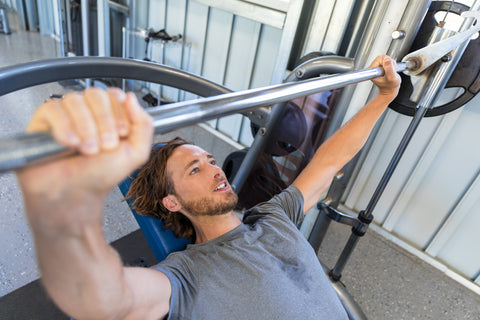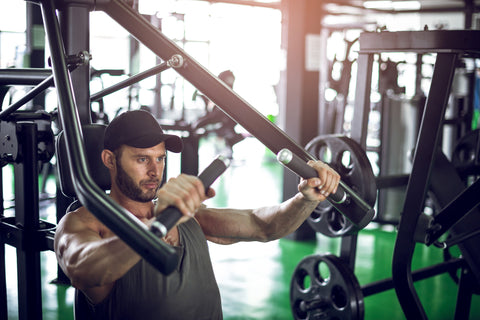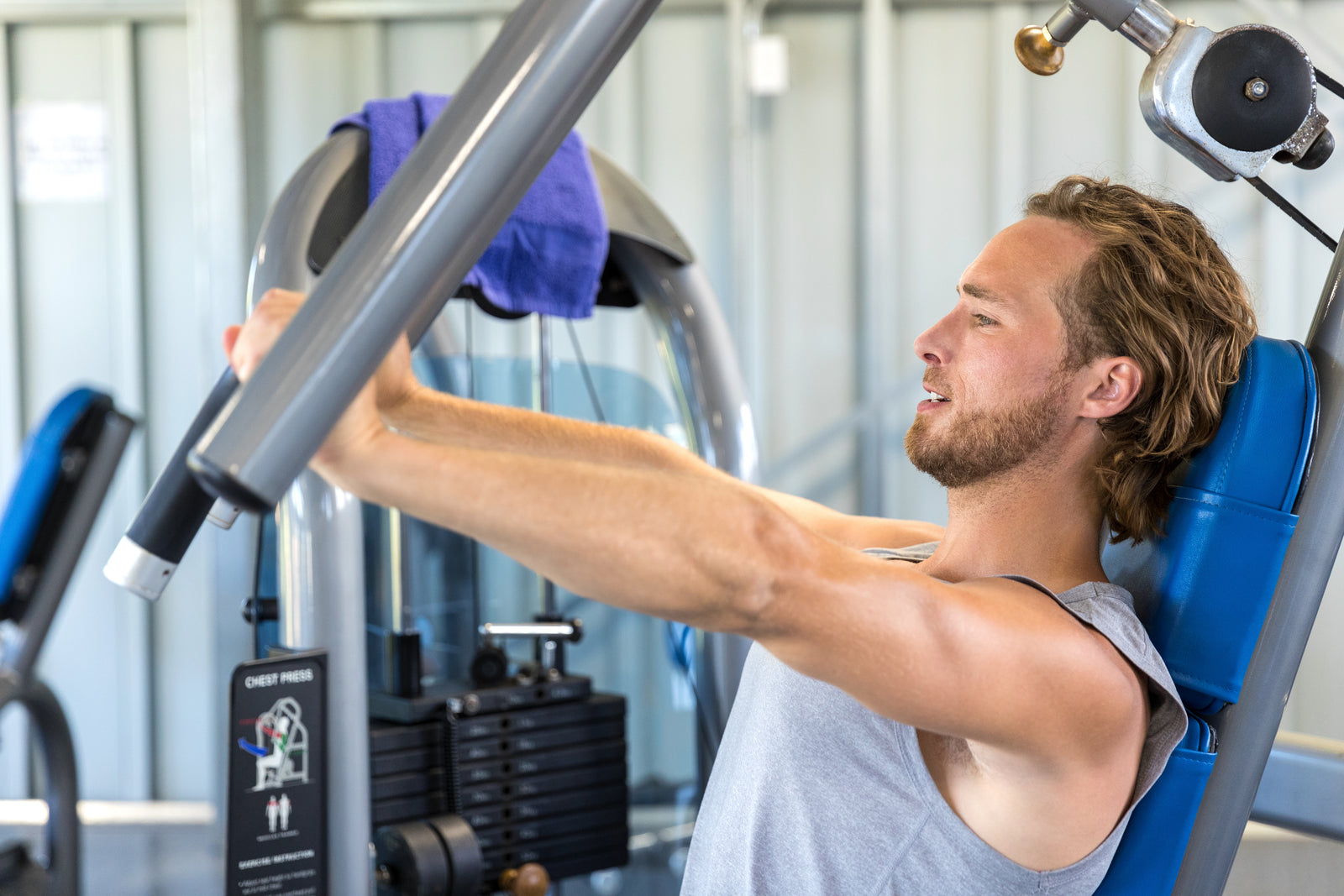

FREE SHIPPING AT $150
YOU'VE EARNED FREE SHIPPING!
FREE SHIPPING AT $150
YOU'VE EARNED FREE SHIPPING!
October 09, 2020 10 min read
In the ongoing quest for bigger and bigger pecs, there are several exercises that step up to the plate and promise to take your chest to the next level. We’ll be talking about two of these: the chest press and the bench press.
There are clear winners and losers in different categories, and depending on what your goals are and where you are right now, either one might be the choice for you. In a way, it comes down to the debate between machines and free weights.
Which one is better for strength? Building muscle? For beginners? We’ll look at these questions (and more) below, but first, let’s take a closer look at each of the respective movements.
Not much can be said about the bench press that hasn’t already been said before. It’s a juggernaut of a lift—a bread-and-butter movement for a large swath of gym goers and something you can find in any self-respecting iron temple in the world.
You meet someone, start talking, and mention that you lift. What’s the first question you’re going to be asked?—“What’s your bench?”
And for good reason. The lift has been a staple for all manner of gym-goers for decades—from bodybuilders to powerlifters to general fitness enthusiasts. All one has to do is look at its decade-long track record in the lifting world to see the benefits it can impart.
It’s practically synonymous with chest development and a de facto move for strengthening the upper body as a whole. If done explosively, it can also help to develop your muscular power and upper-body explosive energy. And since it’s a heavy, compound movement, it comes with all the goodies that compound movements help with, including:
Let’s take a closer look at the muscles worked by the bench press since that plays a major role in the bench x chest press debate.
As such a big lift, the bench press works several major muscle groups—not just in the upper body.
The most important, of course, are the pectoral muscles (and specifically the pectoralis major). Helping with the horizontal flexion of the shoulder joint, they’re necessary for any functional pushing actions. There’s also the anterior deltoids, or front delts, which come into play in a variety of chest exercises. The final most important piece of the puzzle is the triceps brachii. They’re what allows your elbow to extend out; absolutely critical for pushing.
Along with those three main muscle groups, we’ve got the lats along the back to help stabilize your shoulders and keep them pulled back with proper bench press form. Your traps and rhomboids also engaged to help with keeping the shoulder blades pulled back. And it’s the rotator cuff that stabilizes the joint itself.
Finally, we’ve got biceps, serratus anterior, lower body muscles, and the core that help to keep your body stabilized throughout the lift. Keep this in mind since it’s a critical difference between the bench press and chest press.

Bench pressing is a compound exercise, which means complexity. Add a heavy weight to the mix and you’ve got a recipe for disaster if you’re not prepared and don’t have good form. The first step is the set-up itself. You want a flat, sturdy bench that’s not too slick.
When you lay flat on the bench, you’ll want the barbell at around eye level while gripping it a bit wider than shoulder-width apart—although this will depend on your body type and the variation you’re doing.
To prepare for the press your chest should puff out, allowing your back to arch. Follow this by bringing your shoulder blades together behind you; imagine having to hold a pencil in between them. Your feet need to be in a stable position for you. There are different schools of thought on this subject, but it’s generally better to pull them back towards your upper body. Now we’re ready.
1. Begin by bracing your core and maintaining your shoulder position (back and down). With your lower back arched, keep your feet rooted to the floor as you press up into the barbell.
2. Unrack the bar while keeping your shoulder blades pinched. Bring the bar down to your lower chest in a controlled manner over a couple of seconds. Elbows should be kept slightly tucked in towards your torso.
3. Keep lowering the bar until it touches your chest. Pause for a moment before explosively reversing the movement.
4. You’ve reached the top of the lift when your elbows lock out. However, don’t go too far/too fast to lose the positioning of your shoulder blades.
5. Repeat for the desired amount of reps.
Also known as the machine press or seated chest press, this exercise requires the use of a machine—as you might’ve guessed.
Machines sometimes get a bad rap, since many see them as being sub-par to free weight training. That, of course, depends on your specific goals. Machines are a tool, and if the tool works for you then why not use it? The trick is in learning how to use it correctly and for maximum benefit.
While the movement is extremely similar to the bench press, there are several ways that the chest press differentiates itself. One of these differences is in the relative ease and safety of the motion.
Using a machine, you're relegated to moving in one, consistent path. The machine only hinges in a certain way, and you’re going along for the ride whether you like it or not. This means that it’s a lot easier to learn to do correctly, and you can spend more time on learning to engage the proper muscles. This also lends itself to the safety of the chest press.
Since you’re not underneath a ton of free weights and the machine only moves so far in each direction, the chances of injury are much slimmer than with a conventional bench press. Not only does injury from improper form become a non-issue, but you’re also not put in any compromising places. That, paired with the fact that the lowest starting weight is usually less than a standard barbell, makes the chest press an excellent way for beginners to get into lifting.
And for those who have a little more experience, the machine press is also great for drop sets—and drop sets are great for putting on mass. By allowing yourself to go until failure with pretty much every set, you can safely and effectively gas out the muscles you want to develop.
The machine press works many of the same muscles as the bench press.
This includes the “big three”: the pecs, front delts, and triceps. But other muscles such as the biceps, traps, rhomboids, rotator cuff, and lats are also engaged throughout the movement. The biggest difference is the fact that a machine will always require less stabilizing and accessory muscles.
With any free weight lift, it’s up to you to control the load every step of the way and in every direction. In pretty much every big lift activation of the core is essential for making sure that the path of the bar (or dumbbell) is the path that is most efficient and “correct”.
A machine doesn’t have this issue since there’s a fixed path that you’re going to take every single time. While engaging other stabilizing muscle groups might prove helpful, it’s far from necessary. This allows you to focus your energy and concentration on moving the weight with your chest, delts, and tris, for the most part.
While not an isolation exercise per se, the machine press does “isolate” in a sense.
When it comes to setting up a successful chest press, it’s going to largely depend on the machine that you have at your disposal. They come in a variety of models, so it might take some time to get accustomed to each.
Generally speaking, however, you’re going to want to align the handles with the middle of your chest when you’re sitting. The seat should be in a position where your feet can maintain strong contact with the floor. Adjust the weight before you begin, and remember: it’s better to go lower when you’re first trying it out.
1. With your feet firmly pressed into the floor, push back so your upper back is firmly pressed into the seat. Allow your lower back to have a small arch while pushing out your chest and engaging your abdominals.
2. Use an overhand grip to grasp the handles of the machine. Sometimes there may be several choices of handles, so pick the ones that are most comfortable.
3. Press through, moving the handles away from you. Keep going until your elbows are straightened out, but don’t allow them to lock at the top.
4. Reverse the movement to come back into the starting position. If you’re going for more reps, don’t allow the weight to come all the way down and rest—you want to maintain constant tension.
The most obvious difference between using a bench and a machine for your chest gains is the use (and non-use) of stabilizing muscles.
We’ve already touched on this above, but the chest press only allows your muscles to move in a predetermined path. The free weight of the bench press, however, means that you’re going to need to work to keep the load moving the way it’s supposed to. This has several different effects.
For one, the chest press is going to allow you to focus on those muscles that you actually want to be working on—the pecs, delts, and tris. By removing stability out of the equation, you’re allowed to place more focus on the muscles that matter with these movements. When it comes to weight, this means two different things.
You should theoretically be able to lift more by using the machine. Not only are your stabilizers out of the equation, but you’re also benefitting from a reduced range of motion. You can’t touch the bar to your chest, since there is no bar. This is technically great from a strength training perspective, but it’s also important to keep in mind that you can max out the machine—and fairly quickly, at that. While some machines allow you to load plates on them, most don’t.
So, when you’ve out-trained the machines, you’re going to need the flexibility of adding as much weight as your heart desires onto a barbell.
Saying that, let’s take a closer look at scenarios when one might trump the other.

The chest press is significantly easier (in terms of form) and requires much less technique than the bench press. This makes it good for two groups of lifters.
There are the beginners who might still have trouble lifting a conventional barbell with proper form. The machine press allows for a lower range of weight to be used, allowing people to train up to the level where they can bench. Furthermore, the chest press doesn’t require a spotter and proper form isn’t some intricate thing. It’s much more important to focus on engaging the correct muscles—something that a beginner can benefit from.
There are also those who might be recovering from an injury. The chest press allows for a much safer option during recovery since nothing can fall on you and the path of the bar is completely controlled. The chest press is a great tool for rehabilitation when trying to build up strength after an injury.
The above factor also plays into the benefit of being able to do the chest press one-handed. Making the movement unilateral allows for a more balanced right/left development when it comes to your muscles.
But for the seasoned lifters, the chest press also allows for drop sets at the end of a workout. If you’re looking to really gas out your chest and upper body, really pushing it with the chest press can yield great results with relative safety. It’s a way to squeeze out everything you can (training till failure) before throwing in the towel, and you don’t need to be worried about dropping the weight.
Lastly, if you’re strapped for time, the chest press should be your go-to option. Changing the weight and setting up is quick and simple, allowing you to get into the exercise faster. With the bench press, there’s barbells, benches, plates, and clips to assemble—even if your gym runs like a tight ship, this will always take time.
The benefit of the bench press is that it’s a full body compound movement to the furthest extent. Just because you can ignore the stabilizers with the chest press, doesn’t mean you should. Those are important muscles as well, and they’re absolutely essential when it comes to all manner of functional and athletic fitness needs.
The bench press will generally garner more development in terms of muscle mass and strength, since you’ll be able to go much heavier on it. The fact that you can include so many different variations of the conventional barbell bench press also means that you can hit your upper body and chest from different angles—unlike with the chest press. This includes movements such as the incline bench press and decline bench.
Your range of motion will also be increased with the bench press since you’re not limited to a machine. This is necessary if you’re looking to work your pecs to their maximum level. And if you’re looking for an even greater range of mobility, opt for the dumbbell bench press since it won't be limited by the bar.
A workout routine with a good chest workout is all but necessary, and you’re well on your way to making it happen. Choosing the right exercises to do is key when it comes to sculpting the physique you’ve always wanted.
But while it’s important to create a workout plan with exercises that bring you towards your goals, it’s even more important to create a diet plan that does the same. It’s been said a million times but it’s worth saying again: you can’t out-train a bad diet.
While many are used to hearing this in terms of eating too much junk food, the problem also lies with not eating enough of the good foods—something that’s particularly important when training for both hypertrophy and strength. You need fuel to keep your body going and growing, and eating like a pigeon is never going to cut it.
The key element will be protein—something that a high-quality protein shake throughout the day can help with. If you back that up with the proper rest, a jacked upper body is sure to follow—whether you opt for the bench or the machine.
